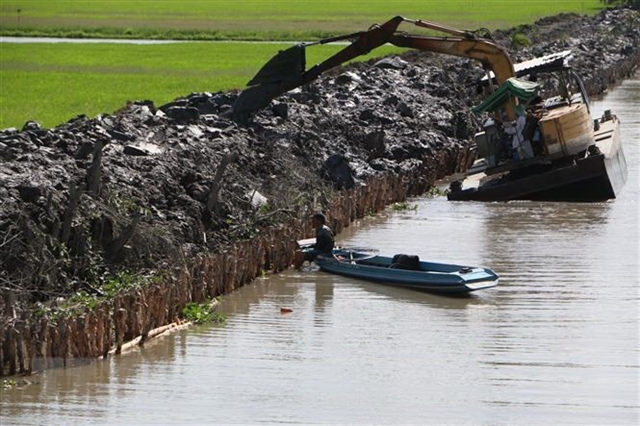 Environment
Environment

The water level at Cambodia’s great lake Tonle Sap is low so the ability to discharge much water for the delta is not high.

|
| Workers dredge a canal to prevent saltwater intrusion and store freshwater in Hậu Giang Province’s Vị Thủy District. VNA/VNS Photo Duy Khương |
HÀ NỘI – Saltwater intrusion in the Mekong Delta might reduce between late March and June this year, according to Phùng Tiến Dũng, head of the Hydrological Forecasting Department for the Central, Central Highlands and Southern region.
Dũng recently said the flow of the Mekong River to the Mekong Delta in February is forecast to be equivalent to the average of many years and 2016.
The water level at Cambodia’s great lake Tonle Sap is low so the ability to discharge much water for the delta is not high.
From mid-March this year, the flow of water to Kratie's (a location in Cambodia) upper basin will increase due to the discharge of reservoirs in line with recent years.
Earlier, the centre forecast that saltwater intrusion will be more serious in 2020 than in previous years.
Saline intrusion on some rivers at certain times might be as severe as in the 2015-2016 dry season which caused VNĐ15 trillion (US$646 million) of damage to the delta.
The peak time for saline intrusion on the Mekong River may occur between January and February and in March this year with Vàm Cỏ and Cái Lớn rivers are the exception.
Dũng also warned that the prolonged lack of rain associated with the exploitation of water resources in the basin would make drought, water shortage and saltwater intrusion worse than in the historic 2015-2016 dry season.
Nguyễn Hữu Thiện, an independent expert on the Mekong Delta’s ecology, agreed.
“With the low water level of the Mekong River this year, the dry season after Tet holiday, with the peak between March and April this year, could be as harsh as predicted,” he said.
Early warnings and measures to prevent possible damage were important, Thiện said.
He suggested agencies call on local residents to store freshwater to ensure enough water for daily use.
Saltwater intrusion has occurred on a large scale in Mekong Delta provinces, coming sooner than previous years.
Saltwater from the sea has entered 60-70 kilometres deep into the Cổ Chiên and Hậu rivers. The salinity intrusion is expected to reach 110km at peak time in some places.
According to reports from Mekong Delta provinces, about 200,000 hectares of winter-spring crops will be affected. Of these, 90,000 hectares will be badly hit.
Nguyễn Văn Tân, director of Kiên Giang Province’s Department of Agriculture and Rural Development said for coastal provinces, saltwater intrusion normally begins after Tết (Lunar New Year) holiday, causing damage to agricultural production.
The affected areas would spread from Rach Gia to Ha Tien City, areas along Cái Lớn and Cái Bé rivers and U Minh Thượng district.
Villages in coastal areas including An Biên, An Minh and Kiên Hải districts will face a water shortage.
Provincial authorities have implemented several projects to mitigate the impacts, including upgrading irrigation projects and building dams to keep out saltwater intrusion.
Similar measures have been taken in An Giang Province.
In addition to asking farmers to restructure rice cultivation, local authorities have been told to share water and use water in canals to save rice and other crops. — VNS



